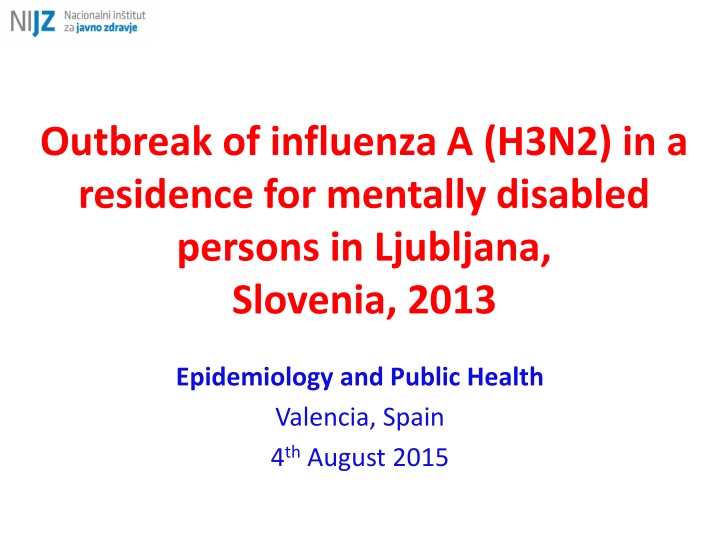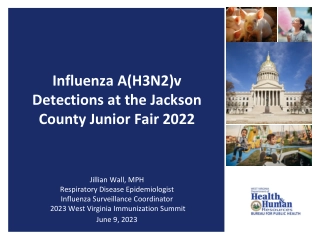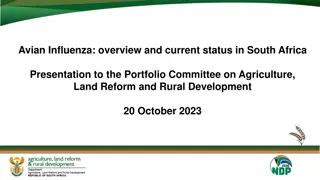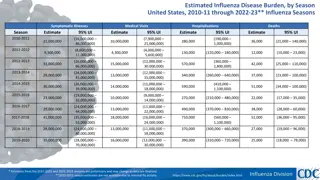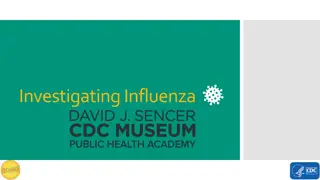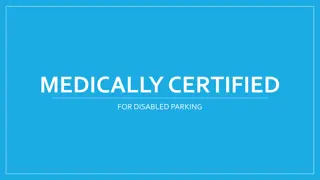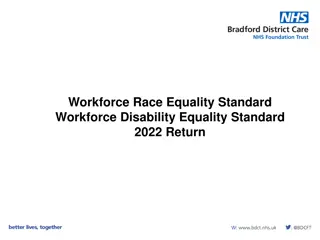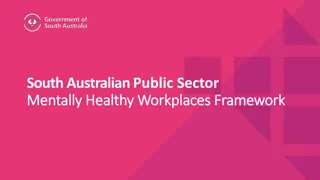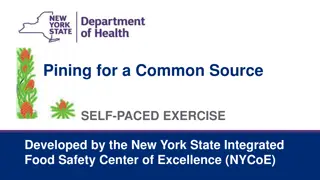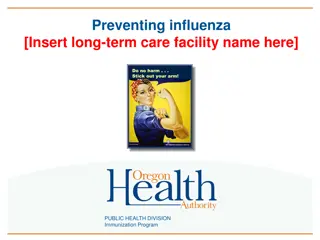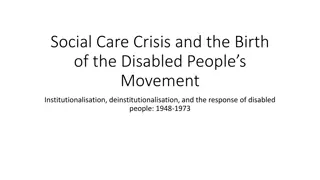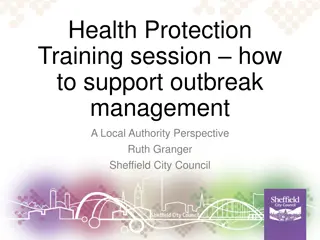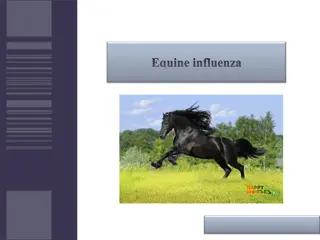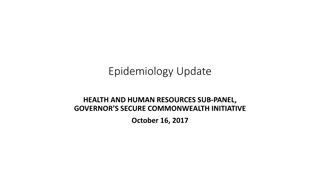Outbreak of Influenza A (H3N2) in a Residence for Mentally Disabled Persons: Epidemiology and Public Health
An overview of an influenza outbreak in a residence for mentally disabled individuals in Ljubljana, Slovenia in 2013, including details on the outbreak alert, case finding, results, symptoms, and more. The incident involved residents and staff members with acute respiratory symptoms, fever, cough, and confirmed cases of the influenza virus. Key statistics such as age distribution, vaccination rates, and clinical manifestations are highlighted.
Download Presentation

Please find below an Image/Link to download the presentation.
The content on the website is provided AS IS for your information and personal use only. It may not be sold, licensed, or shared on other websites without obtaining consent from the author.If you encounter any issues during the download, it is possible that the publisher has removed the file from their server.
You are allowed to download the files provided on this website for personal or commercial use, subject to the condition that they are used lawfully. All files are the property of their respective owners.
The content on the website is provided AS IS for your information and personal use only. It may not be sold, licensed, or shared on other websites without obtaining consent from the author.
E N D
Presentation Transcript
Outbreak of influenza A (H3N2) in a residence for mentally disabled persons in Ljubljana, Slovenia, 2013 Epidemiology and Public Health Valencia, Spain 4thAugust 2015
Outbreak of influenza A: Background Outbreak alert: 27 January 2013 3 persons with acute respiratory symptoms in a LTCF for mentally disabled in Ljubljana occurred 25 January 48 residents; 45 employees (1 GP, 2 nurses); majority bed bound, skilled care/rehabilitation Outbreak control team: convened on 27 January Objective: to characterize outbreak, identify factors associated with contracting infection, recommend control measures
Outbreak of influenza A: Case finding and description Case: resident or employee of the residence for mentally disabled with fever ( 37.5 C) and cough or any other additional sy between January 25 and 29, 2013 (ILI) + LAB confirmed influenza virus (confirmed) Microbiology: respiratory pathogens, including influenza viruses
Outbreak of influenza A: Results Index case: 35 yr old employee 8 cases among residents (17% of all residents); 5 cases among staff (11% of all staff) Age: average: 36.8 yrs (range: 13-51); 40-59 yrs: 54% Female:male=1.6:1 Bed ridden: 100% of all residents Vaccinated: 0 staff, 5 residents; 24 (50% of all residents), 7 (16% of all staff)
Outbreak of influenza A: Cases of influenza by date of onset
Outbreak of influenza A: Results Staff: first cases, presentation dispersed Residents: peak of the outbreak Hospitalized: 2 residents Laboratory investigation: Influenza A (H3N2): 2 cases Negative for other respiratory pathogens
Outbreak of influenza A: Symptoms and signs reported by cases Clinical manifestation No. of individuals (%) Fever 13 (100) Cough 10 (76.9) Sore throat 5 (38.5) Myalgia 5 (38.5) Headache 5 (38.5) Pneumonia 2 (15.4)
Outbreak of influenza A: Control measures Hand hygiene/disinfection, personal protective equipment, airing of rooms, Excluding ill staff, no residents group activities until 7 days after cessation of symptoms Cohort isolation of symptomatic residents Reducing staff exchange, no new admissions
Outbreak of influenza A: Conclusions Staff possibly initiated and contributed to the maintenance of transmission To comply with vaccination recommendations, especially for staff working with persons with risk factors
Influenza outbreaks in facilities: Surveillance Sentinel network of GPs Weekly No. of consultations for ILI Samples of nasal swabs Influenza viruses and type identification
Influenza outbreaks in facilities: Case finding and definition Case: fever and cough and 1 additional symptom (sore throat, arthralgia, myalgia, prostration) (ILI) laboratory confirmed influenza (confirmed) Outbreak in facility: 2 cases within 7 days and with evidence with spread
Influenza outbreaks in facilities: Measures Notification of PH authorities Nasopharyngeal swabs for influenza testing Implementation of infection control measures Antiviral chemoprophylaxis
Influenza outbreaks in facilities per month: 2011 2015 Month Number of outbreaks (%) Jan 10 (24.4) Feb 20 (48.8) March 10 (24.4) April 1 (2.4)
Influenza outbreaks in facilities, duration: 2011 2015 Year Number of outbreaks (%) Average duration (Min Max) (days) 2011 3 (7.3) 13 (6 17) 2012 10 (24.4) 13 (2 24) 2013 6 (14.6) 11 (2 31) 2014 8 (19.5) 23 (7 49) 2015 14 (34.2) 11 (2 22) All outbreaks 41 (100) 14 (2 49)
Influenza outbreaks in facilities, distribution: 2011 2015
Attack rates by facility type: 2011 2015 Facility Number of outbreaks (%) AR (Average) AR (Min-Max) Elderly 20 (48.8) 20.3 5.2 42.3 Hospital 7 (17.1) 20.5 11.1 40.0 Kindergarten 1 (2.4) 34.2 Institute 1 (2.4) 16.3 Mentally disabled 12 (29.3) 20.3 5.2 38.9 All outbreaks 41 (100) 20.6 3.1 42.3
Hospitalization rates by facility type: 2011 2015 Facility Number of outbreaks HR (Average) HR (Min-Max) Elderly 20 (48.8) 7.5 0 37.0 Hospital 7 (17.1) 5.7 0 40.0 Institute 1 (2.4) 0 Kindergarten 1 (2.4) 7.3 Mentally disabled 12 (29.3) 11.5 0 40.0 All outbreaks 41 (100) 8.0 0 40.0
Attack rates by influenza virus type: 2011 2015 Influenza virus Number of outbreaks (%) AR (Median) AR (Q1-Q3) A 34 (82.9) 16.0 13.1 26.1 B 5 (12.2) 20.2 11.5 24.0 A+B 2 (4.9) 25.2 16.3 34.2 All outbreaks 41 (100) 20.0 13.1 26.1
Influenza outbreaks in facilities, MVA: 2011 2015 Delayed notification was associated with increase in the death rate among residents (p < 0.001) and outbreak duration (p=0.027) regardless of facility type/size and viral aetiology The effects of facility type/size and viral aetiology on the average residents' death and attack rates, duration of outbreaks and time to report to PH authorities was not significant
Influenza outbreaks in facilities, conclusion: 2011 2015 Timely identification and reporting of influenza outbreaks to PH authorities and prompt implementation of competent infection control measures by PH authorities: Shorter duration of outbreaks Lower mortality among the infected residents
Outbreak of influenza A: Recommendations Outbreaks of influenza should be reported as soon as possible to put control measures in time and prevent future occurrences in LTCFs Rapid agent identification crucial to control spread of infection Staff vaccine uptake focus Optimal vaccine provision models Public health support
Influenza outbreaks in facilities: Risk factors Outbreaks of influenza reported every year Risk factors: age, comorbidities, dementia (institutionalised elderly), shortage of staff, insufficient knowledge of infection control measures More severe and longer duration
Residents in longterm care facilities (LTCF) Anatomical and functional changes Comorbidities/polimedication Implants, catheters Malnutrition Frequent/prolonged ambulatory care and hospitalization Multiple diagnostic and therapeutic interventions Closed environment Limited mobility Increased susceptibility to infections
Influenza in residents of LTCF Symptoms atypical or absent Diagnosis unrecognized and/or undertreated Prolonged hospital stay Low influenza vaccination coverage Higher morbidity and mortality
